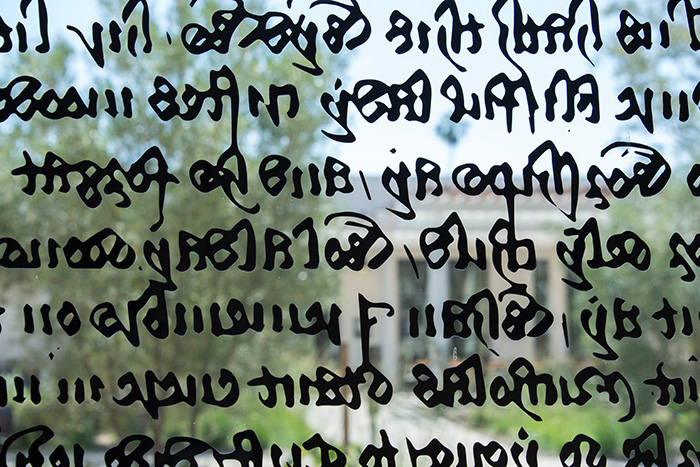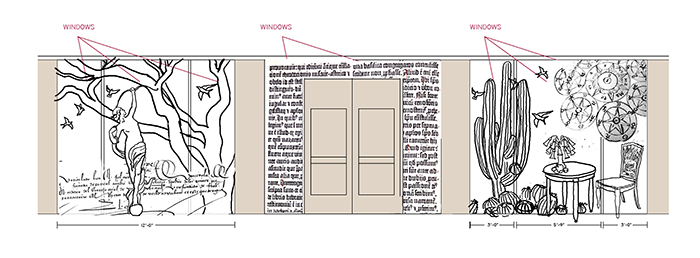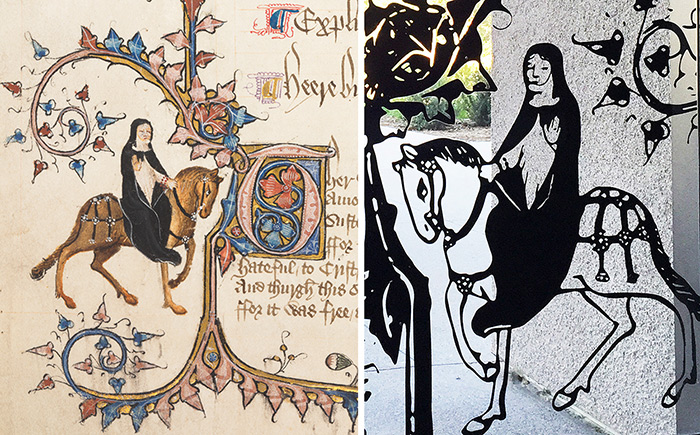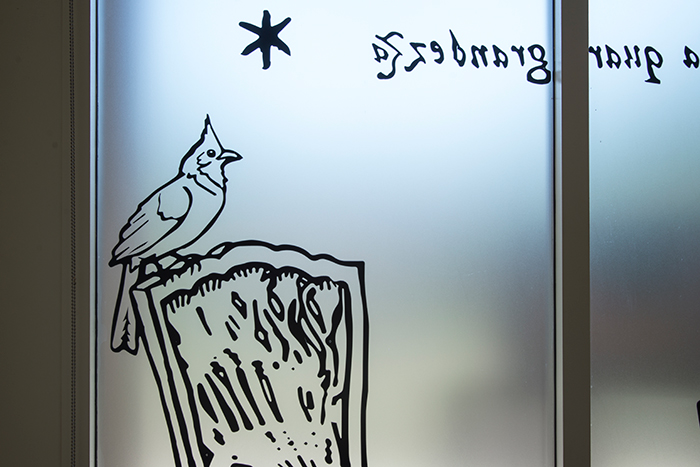The Huntington’s blog takes you behind the scenes for a scholarly view of the collections.
A Window into The Huntington
Posted on Fri., July 24, 2015 by

Chaucerian calligraphy lends its intricate forms to the front windows of the Mapel Orientation Gallery.
Before entering the Mapel Orientation Gallery, take a moment to notice the elegant outlines floating on the front windows. These silhouettes, which greet you as you enter and bid you a pleasant day as you leave, are a snapshot of The Huntington’s library, art, and botanical collections.
Portland, Ore.-based artist Katura Reynolds envisioned “…something that felt like a sort of mad tea party, Huntington-style.” True to her words, Reynolds created a playful jumble of Huntington icons—juxtaposing an otherworldly cactus with a pristine Tiffany lamp and a section from Alessandro Piccolomini’s 16th-century Star Chart, among other items—and succeeded in blending them into a coherent whole. To correctly identify the dozen objects represented in her design, pick up a laminated key to the front window art at the gallery’s information desk.

A preliminary “doodle” shows a celestial motif in the upper right-hand corner above the Mackmurdo chair. The final composition omitted the celestial motif and replaced it with quotes from Alessandro Piccolomini’s Star Chart (1540).
In order to create her vision, Reynolds used a stylus, graphic tablet, and Photoshop software to draw her initial doodles. The hand drawings then went through multiple revisions, virtual cleanups, and layout edits before emerging as clean illustrations with bold and flowing lines. Recreating the intricacies of quill-written text proved especially challenging. Reynolds ended up making high-resolution scans of the library materials to create a black-and-white digital copy. With certain parts of Chaucer’s Canterbury Tales, she had to redraw the text for better contrast.
The effortless quality of the final drawings belies the challenge Reynolds faced as she struggled with scaling up images to fill each 12-foot-wide window. As an artist who specializes in science and nature drawings, Reynolds is accustomed to working on a smaller scale. To achieve the larger scale, she created an Excel spreadsheet that calculated proportions for each item; then, as if by magic, the tiny drawings started to fill up the space. “It’s the first time I’ve used a spreadsheet in an art project!” she says.

“In the original, you can see the contrast between the red, the gold, and the blue, but when it shifted to black and white, all that became just a dark blob,” explains Katura Reynolds, describing the challenge of transferring the 600-year-old illuminated manuscript to window stencils. Left: Geoffrey Chaucer (ca. 1343–1402), The Prioress’s Tale, from the Ellesmere manuscript of The Canterbury Tales, England, ca. 1400–1405. The Huntington Library, Art Collections, and Botanical Gardens. Right: detail of the prioress in the Mapel Orientation Gallery window.
Despite the challenges, the completed windows manage to encompass the diverse collections at The Huntington in subtle yet unexpected ways. For instance, Reynolds placed a red-whiskered bulbul on the edge of an Arthur Heygate Mackmurdo 19th-century chair, further accentuating the chair’s soft, natural lines. Reynolds worked with gallery designer Karina White to capture a certain mood for the design. “We both wanted it to have a playful feel while acknowledging the dignity and history of the content. I think it worked out really well,” said Reynolds.
The next time you visit The Huntington, be sure to check out the Mapel Orientation Gallery's windows; they may inspire the itinerary for your next tour of the grounds.

A red-whiskered bulbul perched on an Arthur Heygate Mackmurdo 19th-century chair playfully juxtaposes the natural realm and man-made craftsmanship, a motif often favored by the Arts and Crafts Movement.
Related content on Verso:
Quirky Tours (Jul. 7, 2015)
Taking the Long View (May 19, 2015)
Let's Get Oriented (Apr. 3, 2015)
Christine Quach is a web editor in the office of communications and marketing at The Huntington.